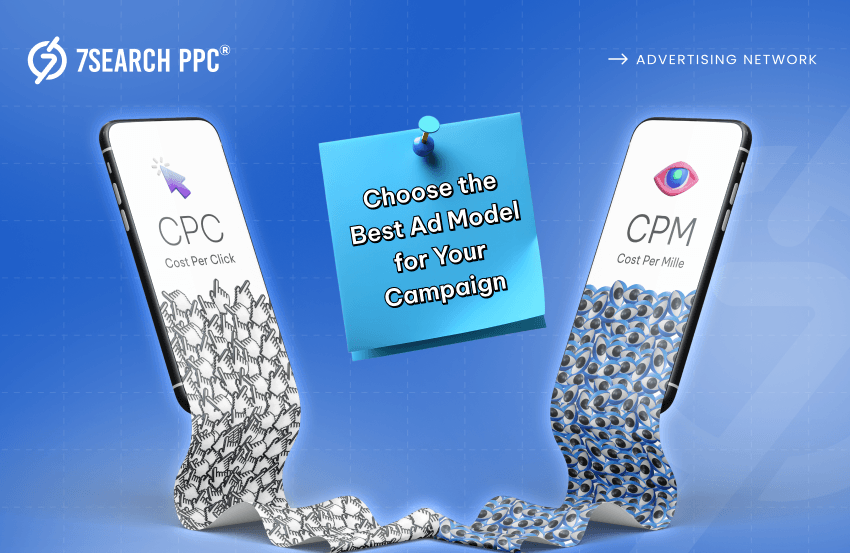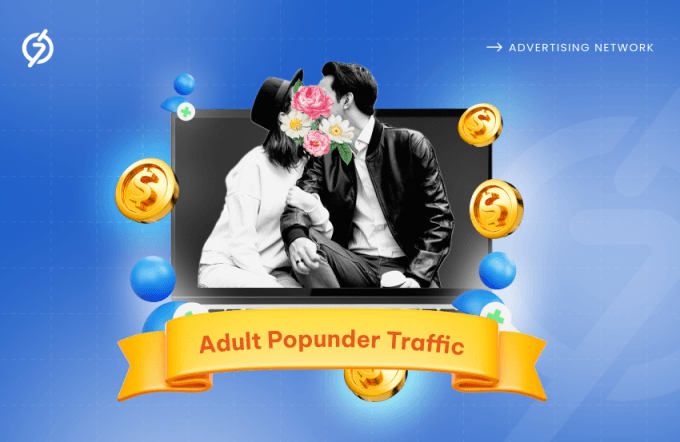Online advertising has become incredibly diverse, offering businesses a wide range of digital marketing strategies to select from. Among the many options, one of the most critical decisions advertisers face is choosing the right advertising pricing model—CPC vs CPM being two of the most commonly used. Each model serves different goals, making it essential to understand which one aligns best with your campaign objectives.
While both models offer unique advantages, selecting the right one can make or break the success of your ad campaign. In this guide, we will focus on the key comparison: CPC vs CPM to help you determine which is more effective for your specific advertising goals, whether it’s driving traffic, boosting impressions, or maximizing ROI.
Run high-performing CPC & CPM ads – Join 7SearchPPC
CPC vs CPM? Know the Difference Before You Advertise
Knowing the difference before you start advertising is important for better results. Let’s take a look at what actually differentiates CPC from CPM.
CPC (Cost Per Click)
CPC, or Cost-Per-Click, is a pricing model where advertisers only pay when a user clicks on their ad, making it a performance-based strategy that helps control costs and engage people effectively. In this model, advertisers set a specific bid, the maximum amount they’re willing to pay per click—and only incur charges when someone interacts with their ad, rather than just viewing it.
This approach allows for measurable results, as each click represents genuine interest, making it ideal for campaigns focused on driving website traffic, leads, or increasing conversions. With Cost Per Click, advertisers can optimize their budget, monitor ROI, and ensure they are paying for actual user actions.
Wondering how to calculate your CPC (Cost-Per-Click) for a PPC campaign? It’s actually pretty simple! Use this easy formula to figure out how much you’re paying for each click:
CPC = Total Ad Spend ÷ Total Clicks
- Total Spend: This is the total amount you have spent on your PPC ad campaign.
- Total Clicks: This is the total number of clicks your ad received.
For example, if you spent $200 and got 500 clicks, your Cost Per Click would be $0.40 (200 ÷ 500 = 0.40).
Know Everything About: What is CPC (Cost-Per-Click) and its Importance?
CPM (Cost Per Mille/Thousand)
CPM, or cost per mille/thousand, is one of the widely used pricing models in digital advertising, especially popular among publishers. In CPM, advertisers pay for every 1,000 impressions their ad receives—regardless of whether users click on it. This pricing model is best suited for businesses looking to increase brand awareness and reach a wider audience.
When comparing CPM vs CPC advertising, it’s easy to assume they function similarly. However, the two are fundamentally different.
Unlike CPC, which charges advertisers only when someone clicks on the ad, CPM is based solely on how many times the ad is viewed. This makes Cost per mille advertising ideal for brand awareness campaigns, while CPC is typically better suited for performance-driven advertising.
Wondering how to calculate your CPM (Cost Per Mille/Thousand) for a PPC campaign? Use this easy formula to figure out how much you’re paying for impressions:
CPM = (Total Ad Spend ÷ Total Impressions) × 1,000
- Total Spend: The total amount you spent on your ad campaign.
- Total Impressions: The total number of times your ad was viewed.
For example, if you spent $150 and your ad was shown 50,000 times, your CPM would be:
(150 ÷ 50,000) × 1,000 = $3
Know More About: What is CPM in Advertising? A Complete Guide for Beginners
CPC vs CPM: A Detailed Comparison
To gain a clearer understanding, it’s important to examine a detailed comparison of CPC vs CPM. These differences include:
Point of Difference
| Point of Difference | CPC (Cost-Per-Click) | CPM (Cost-Per-Mille) |
|---|---|---|
| How You Pay | Per click on your ad | Per 1,000 ad impressions |
| Best For | Performance marketing, sales funnels | Awareness campaigns, product launches |
| Pricing | Usually higher per unit, but more ROI-focused | Usually cheaper per 1,000 views |
| Main Goal | Drive traffic, leads, or conversions | Increase brand awareness & visibility |
| Risk Level | Lower risk – you only pay for engagement | Moderate risk – you pay regardless of engagement |
CPC vs CPM: What Advertisers Gain and Risk with Each Model
Every pricing model comes with its own set of advantages and drawbacks. When it comes to CPC vs CPM, the right choice ultimately depends on your campaign goals, budget, and desired outcomes.
To help you decide which model fits your strategy best, let’s break down the pros and cons of CPM vs CPC so you can make a more informed decision.
Benefits of Cost Per Click Advertising
Below are some benefits of the CPC pricing model:
Pay only for Results
CPC is a pricing model where you only pay when you get results. With cost-per-click advertising, if a person clicks on your ad, then you are required to pay. However, if there are no clicks on the ad, no money will be spent. This makes CPC a cost-effective model where you’re only charged for actual engagement.
Generation of Potential Leads
No business can run successfully if they don’t generate potential leads on time. CPC pricing models enable advertisers to track the number of clicks received from their ad campaign. Advertisers can target those leads and easily convert them into potential customers.
Disadvantages of Cost Per Click Advertising
Here are some disadvantages of the CPC pricing model:
Pay For Unwanted Clicks
As we mentioned earlier, not all clicks lead to potential leads. Advertisers using CPC pricing models will incur charges for every click generated by their ads. This is true regardless of whether those clicks result in a genuine lead, as some may be fraudulent.
Read More About: What Is Click Spam And How Does It Impact Your Advertising?
High Costs
If you have chosen CPC, you’ll have to spend more to get results. CPC advertising can become expensive quickly, particularly for popular or competitive keywords, as it drives up costs and potentially exceeds your allocated budgets.
Benefits of Cost Per Mille Advertising
Here are some benefits that the CPM pricing model offers:
High Brand Visibility
Advertisers choosing a CPM pricing model aim to increase their online visibility. This method is ideal for raising brand awareness because you pay for every 1,000 impressions, regardless of clicks.
Better Planning and Budgeting
By choosing CPM, advertisers can improve planning and budgeting. Since costs are based on impressions, they can estimate reach and control spending more easily, resulting in more predictable campaign budgets and easier performance tracking.
Disadvantages of Cost Per Mille Advertising
Here are a few disadvantages of the CPM pricing model:
Risk of Fraud
In a CPM advertising model, the risk of fraud can become a major headache for advertisers. Since you pay for impressions rather than actual engagement, you can be subject to ad fraud.. By generating fake impressions or bot traffic, fraudsters can drain your advertising budgets without reaching real users or driving conversions..
Potential of Ad Blindness
Selecting a CPM advertising model can lead to potential ad blindness because it focuses on displaying ads to as many users as possible, without ensuring that those users are engaged. The primary objective is to increase the number of impressions to enhance revenue for publishers. However, this strategy can lead to the repetition of irrelevant or poorly targeted ads, causing users to ignore them eventually.
Read: How to Meet Your Finance Advertising Goal Using Targeted Promotions
Conclusion
Choosing between CPC and CPM depends on your advertising goals. CPC is ideal for performance-driven campaigns focused on clicks, leads, or conversions, while CPM is better for brand awareness and visibility. Each model has its strengths and limitations, so it’s essential to align your choice with your budget and marketing objectives. By understanding the key differences and how each model works, advertisers can make more informed decisions and achieve better results.
Frequently Asked Questions (FAQs)
Which one is better between CPC vs CPM?
Ans. Both options have their own benefits, so the right choice really depends on what you are aiming for. If you want to boost clicks, leads, and conversions, CPC is a great way to go. On the other hand, if you’re looking to boost your brand’s visibility, then CPM might be the better fit. Remember, it all comes down to your specific goals.
Is CPM cheaper than CPC?
Ans. Yes, CPM is cheaper in terms of CPC because choosing CPC generally costs more due to its ability to deliver better results. CPC is useful for generating leads, while CPM is mainly effective for brand visibility and rarely results in leads.
Apart from CPC vs CPM, is there any other pricing model available?
Ans. Yes, apart from CPC vs CPM, there is CPA (Cost per Acquisition), which is also an effective pricing model that can help you. CPA is a pricing model where advertisers only pay when a user completes a predefined, valuable action, such as a registration, download, or purchase.
If I start a business and advertise it, which pricing model is best?
Ans. If you have started a new business, choosing pricing models like CPM can be beneficial for you. With a new business, prioritize brand visibility over immediate sales, and a pricing model like CPM facilitates this goal.
Which ad network offers the best options for choosing between CPM and CPC pricing models?
Ans. The best ad network for choosing between CPM or CPC pricing models depends on your campaign goals and target audience. Platforms like 7SearchPPC offer both options, making them a consideration for advertisers exploring flexible pricing strategies.
















![Sports Advertising Campaign Ideas: [2026 Events + Ad Strategies Explained] 5 Sports Advertising](https://www.7searchppc.com/blog/wp-content/uploads/2025/11/Sports-Advertising-680x442.png)
